Infant MAZDA MODEL B4000 2003 Owners Manual
[x] Cancel search | Manufacturer: MAZDA, Model Year: 2003, Model line: MODEL B4000, Model: MAZDA MODEL B4000 2003Pages: 250, PDF Size: 2.85 MB
Page 6 of 250
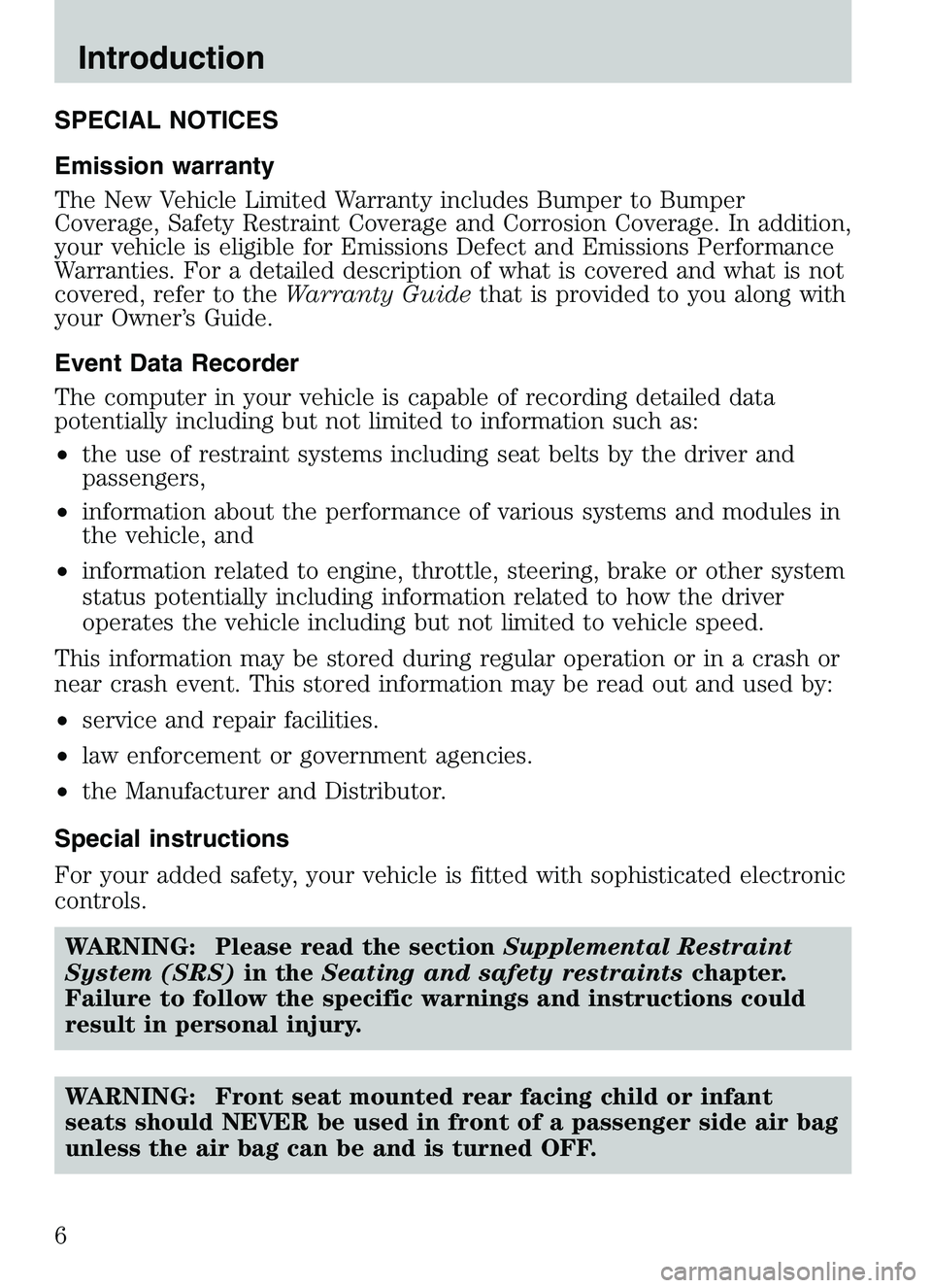
SPECIAL NOTICES
Emission warranty
The New Vehicle Limited Warranty includes Bumper to Bumper
Coverage, Safety Restraint Coverage and Corrosion Coverage. In addition,
your vehicle is eligible for Emissions Defect and Emissions Performance
Warranties. For a detailed description of what is covered and what is not
covered, refer to theWarranty Guidethat is provided to you along with
your Owner’s Guide.
Event Data Recorder
The computer in your vehicle is capable of recording detailed data
potentially including but not limited to information such as:
• the use of restraint systems including seat belts by the driver and
passengers,
• information about the performance of various systems and modules in
the vehicle, and
• information related to engine, throttle, steering, brake or other system
status potentially including information related to how the driver
operates the vehicle including but not limited to vehicle speed.
This information may be stored during regular operation or in a crash or
near crash event. This stored information may be read out and used by:
• service and repair facilities.
• law enforcement or government agencies.
• the Manufacturer and Distributor.
Special instructions
For your added safety, your vehicle is fitted with sophisticated electronic
controls. WARNING: Please read the section Supplemental Restraint
System (SRS) in theSeating and safety restraints chapter.
Failure to follow the specific warnings and instructions could
result in personal injury.
WARNING: Front seat mounted rear facing child or infant
seats should NEVER be used in front of a passenger side air bag
unless the air bag can be and is turned OFF.
Introduction
6
Page 83 of 250

WARNING: Never place a rear facing infant seat in the front
seat unless the passenger air bag is turned off.
Steps you can take to properly position yourself away from the airbag:
• Move your seat to the rear as far as you can while still reaching the
pedals comfortably.
• Recline the seat slightly (one or two degrees) from the upright
position.
WARNING: Do not put anything on or over the air bag module
including hands or feet. Placing objects on or over the air bag
inflation area may cause those objects to be propelled by the
air bag into your face and torso causing serious injury.
WARNING: Do not attempt to service, repair, or modify the Air
Bag Supplemental Restraint System or its fuses. See your
authorized Mazda dealership.
WARNING: Modifications to the front end of the vehicle,
including frame, bumper, front end body structure, tow hooks
and snow plows may effect the performance of the air bag
sensors increasing the risk of injury. Do not modify the front
end of the vehicle.
WARNING: Additional equipment may effect the performance
of the air bag sensors increasing the risk of injury. Consult your
authorized Mazda dealership before installation of additional
equipment.
WARNING: The front passenger air bag is not designed to offer
protection to an occupant in the center front seating position.
Seating and Safety Restraints
83
Page 90 of 250

WARNING: If the light is illuminated when the passenger air
bag ON/OFF switch is in the ON position and the ignition switch
is ON, have the passenger air bag ON/OFF switch serviced at
your authorized Mazda dealership immediately.
The passenger side air bag should always be ON (the air bag OFF light
should notbe illuminated) except for certain vulnerable persons. See
guidance on following pages.
WARNING: The safety belts for the driver and right front
passenger seating positions have been specifically designed to
function together with the air bags in certain types of crashes.
When you turn OFF your air bag, you not only lose the
protection of the air bag, you also may reduce the effectiveness
of your safety belt system, which was designed to work with the
air bag. Most vehicles with full back seats do not have cut-off
switches, but NHTSA and Transport Canada will allow a cut-off
switch to be installed on request for a certain category of
persons who must ride up front and there is a concern about
riding there. Please see the guidance below.
WARNING: Always use safety belts and child restraints
properly. If a child in a rear facing infant seat must be
transported in front, the passenger air bag mustbe turned OFF.
This is because the back of the infant seat is too close to the
inflating air bag and the risk of a fatal injury to the infant when
the air bag inflates is substantial.
The vast majority of drivers and passengers over the age of 12 years are
much safer with an air bag than without. To do their job and reduce the
risk of life threatening injuries, air bags must open with great force, and
this force can pose a potentially deadly risk in some situations,
particularly when a front seat occupant is not properly buckled up. The
most effective way to reduce the risk of unnecessary air bag injuries
without reducing the overall safety of the vehicle is to make sure all
occupants are properly restrained in the vehicle, especially in the front
seat. This provides the protection of safety belts and permits the air bags
to provide the additional protection they were designed to provide. If
you choose to deactivate your air bag, you are losing the very significant
risk reducing benefits of the air bag and you are also reducing the
Seating and Safety Restraints
90
Page 91 of 250

effectiveness of the safety belts, because safety belts in modern vehicles
are designed to work as a safety system with the air bags.
Read all air bag Warning labels in the vehicle as well as the other
important air bag instructions and Warnings in this Owner’s Guide.
NHTSA gives permission to install airbag cut-off switches in the
following terms:1. Infant. An infant (less than 1 year old) must ride in the front seat
because:
• the vehicle has no rear seat;
• the vehicle has a rear seat too small to accommodate a rear-facing
infant seat; or
• the infant has a medical condition which, according to the infant’s
physician, makes it necessary for the infant to ride in the front so that
the driver can constantly monitor the child’s condition.
2. Child age 1 to 12. A child age 1 to 12 must ride in the front seat
because:
• the vehicle has no rear seat;
• although children ages 1 to 12 ride in the rear seat(s) whenever
possible, children ages 1 to 12 sometimes must ride in the front
because no space is available in the rear seat(s) of the vehicle; or
• the child has a medical condition which, according to the child’s
physician, makes it necessary for the child to ride in the front seat so
that the driver can constantly monitor the child’s condition.
3. Medical condition. A passenger has a medical condition which,
according to his or her physician:
• causes the passenger air bag to pose a special risk for the passenger;
and
• makes the potential harm from the passenger air bag in a crash
greater than the potential harm from turning OFF the air bag and
allowing the passenger, even if belted, to hit the dashboard or
windshield in a crash.
Seating and Safety Restraints
91
Page 92 of 250
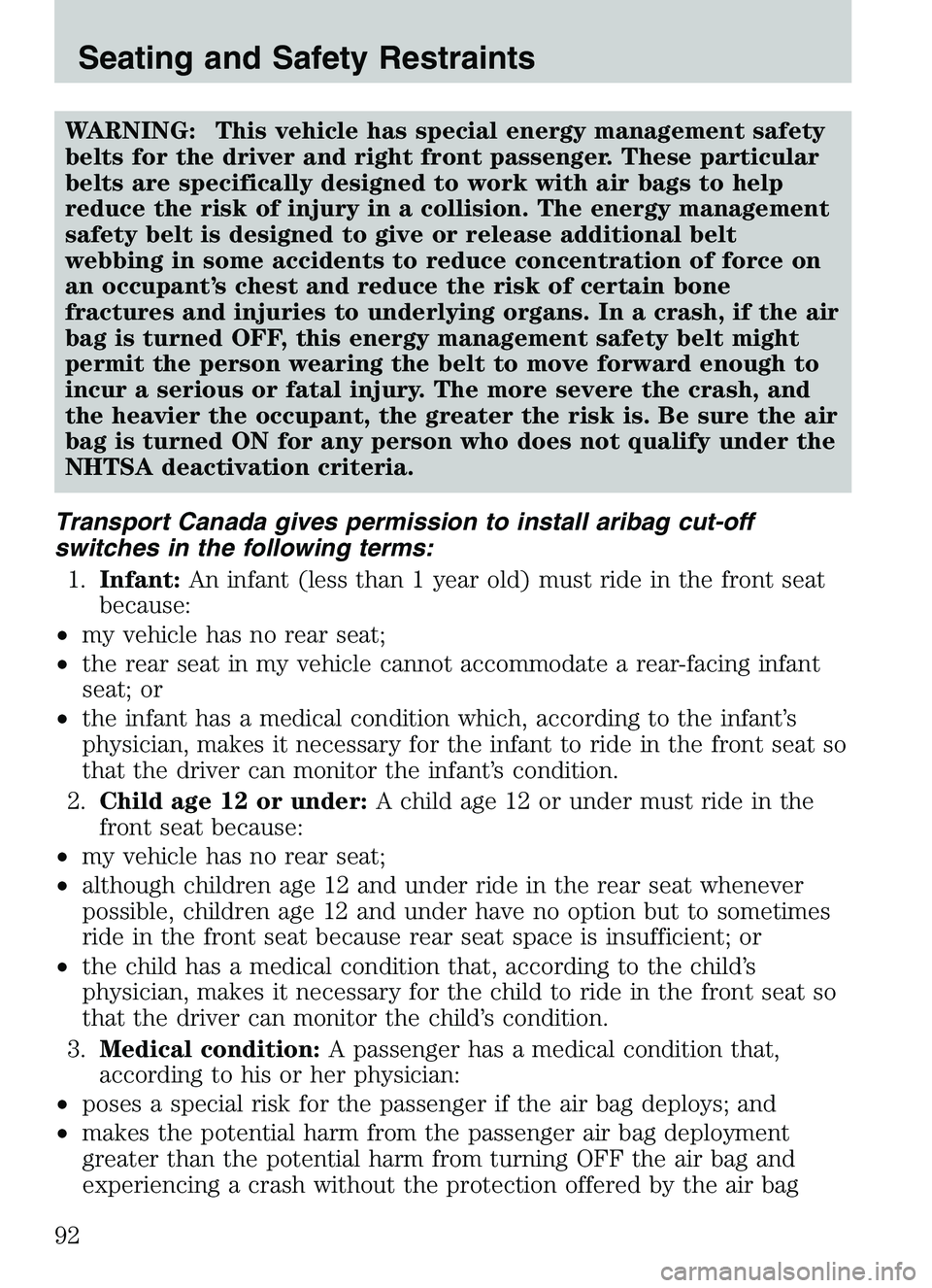
WARNING: This vehicle has special energy management safety
belts for the driver and right front passenger. These particular
belts are specifically designed to work with air bags to help
reduce the risk of injury in a collision. The energy management
safety belt is designed to give or release additional belt
webbing in some accidents to reduce concentration of force on
an occupant’s chest and reduce the risk of certain bone
fractures and injuries to underlying organs. In a crash, if the air
bag is turned OFF, this energy management safety belt might
permit the person wearing the belt to move forward enough to
incur a serious or fatal injury. The more severe the crash, and
the heavier the occupant, the greater the risk is. Be sure the air
bag is turned ON for any person who does not qualify under the
NHTSA deactivation criteria.
Transport Canada gives permission to install aribag cut-off
switches in the following terms: 1. Infant: An infant (less than 1 year old) must ride in the front seat
because:
• my vehicle has no rear seat;
• the rear seat in my vehicle cannot accommodate a rear-facing infant
seat; or
• the infant has a medical condition which, according to the infant’s
physician, makes it necessary for the infant to ride in the front seat so
that the driver can monitor the infant’s condition.
2. Child age 12 or under: A child age 12 or under must ride in the
front seat because:
• my vehicle has no rear seat;
• although children age 12 and under ride in the rear seat whenever
possible, children age 12 and under have no option but to sometimes
ride in the front seat because rear seat space is insufficient; or
• the child has a medical condition that, according to the child’s
physician, makes it necessary for the child to ride in the front seat so
that the driver can monitor the child’s condition.
3. Medical condition: A passenger has a medical condition that,
according to his or her physician:
• poses a special risk for the passenger if the air bag deploys; and
• makes the potential harm from the passenger air bag deployment
greater than the potential harm from turning OFF the air bag and
experiencing a crash without the protection offered by the air bag
Seating and Safety Restraints
92
Page 93 of 250
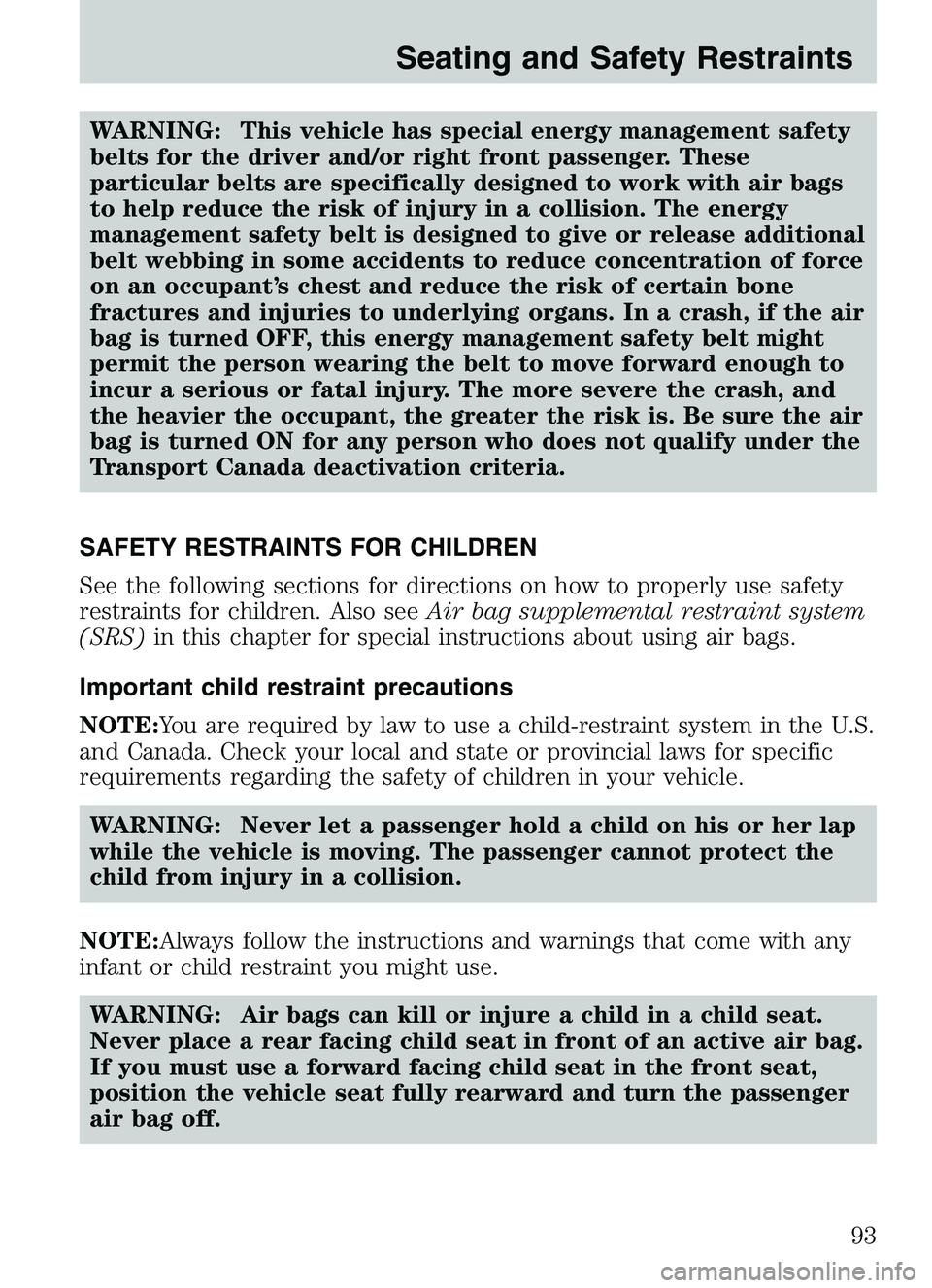
WARNING: This vehicle has special energy management safety
belts for the driver and/or right front passenger. These
particular belts are specifically designed to work with air bags
to help reduce the risk of injury in a collision. The energy
management safety belt is designed to give or release additional
belt webbing in some accidents to reduce concentration of force
on an occupant’s chest and reduce the risk of certain bone
fractures and injuries to underlying organs. In a crash, if the air
bag is turned OFF, this energy management safety belt might
permit the person wearing the belt to move forward enough to
incur a serious or fatal injury. The more severe the crash, and
the heavier the occupant, the greater the risk is. Be sure the air
bag is turned ON for any person who does not qualify under the
Transport Canada deactivation criteria.
SAFETY RESTRAINTS FOR CHILDREN
See the following sections for directions on how to properly use safety
restraints for children. Also see Air bag supplemental restraint system
(SRS) in this chapter for special instructions about using air bags.
Important child restraint precautions
NOTE:You are required by law to use a child-restraint system in the U.S.
and Canada. Check your local and state or provincial laws for specific
requirements regarding the safety of children in your vehicle. WARNING: Never let a passenger hold a child on his or her lap
while the vehicle is moving. The passenger cannot protect the
child from injury in a collision.
NOTE:Always follow the instructions and warnings that come with any
infant or child restraint you might use. WARNING: Air bags can kill or injure a child in a child seat.
Never place a rear facing child seat in front of an active air bag.
If you must use a forward facing child seat in the front seat,
position the vehicle seat fully rearward and turn the passenger
air bag off.
Seating and Safety Restraints
93
Page 97 of 250
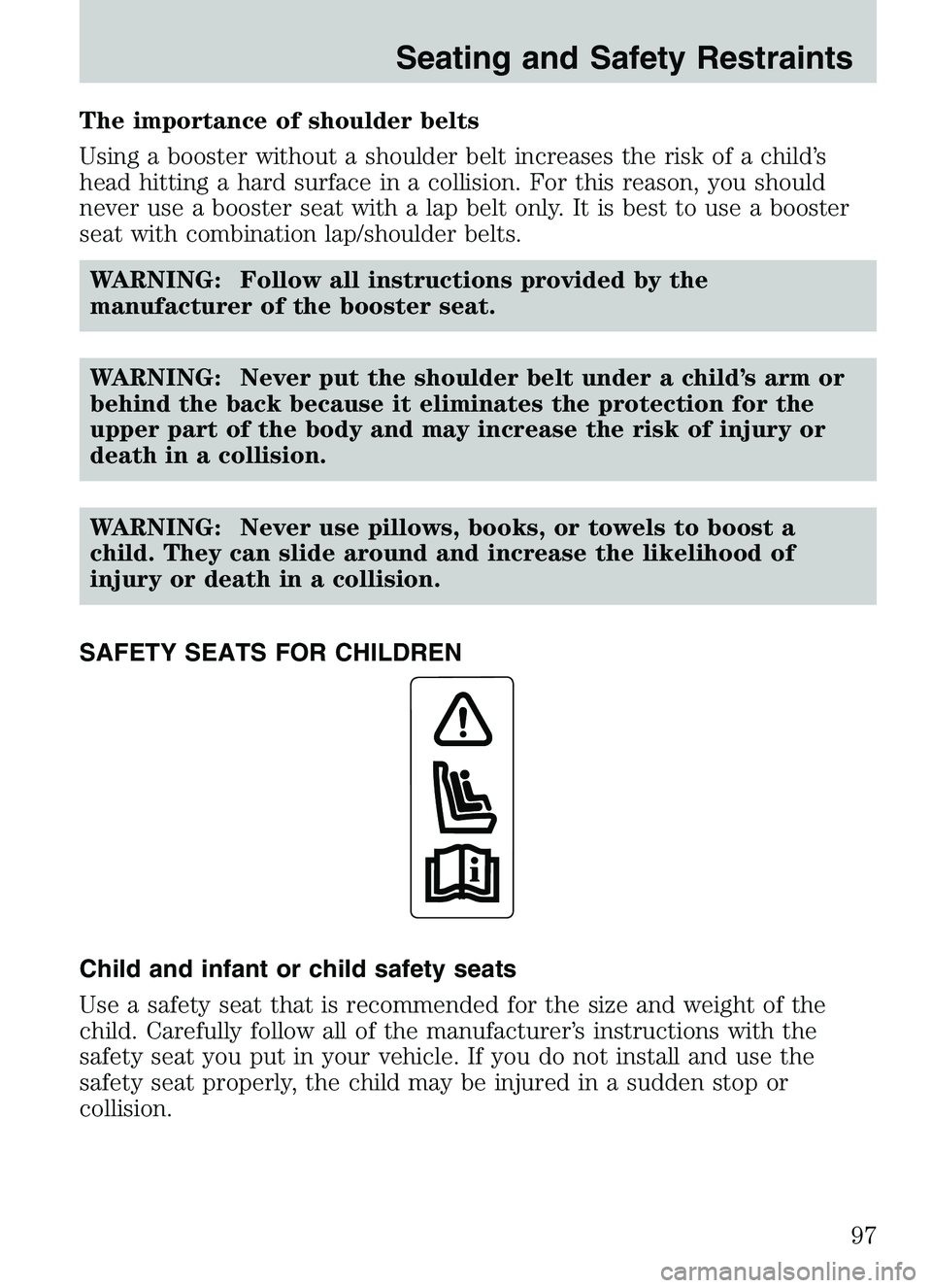
The importance of shoulder belts
Using a booster without a shoulder belt increases the risk of a child’s
head hitting a hard surface in a collision. For this reason, you should
never use a booster seat with a lap belt only. It is best to use a booster
seat with combination lap/shoulder belts.WARNING: Follow all instructions provided by the
manufacturer of the booster seat.
WARNING: Never put the shoulder belt under a child’s arm or
behind the back because it eliminates the protection for the
upper part of the body and may increase the risk of injury or
death in a collision.
WARNING: Never use pillows, books, or towels to boost a
child. They can slide around and increase the likelihood of
injury or death in a collision.
SAFETY SEATS FOR CHILDREN
Child and infant or child safety seats
Use a safety seat that is recommended for the size and weight of the
child. Carefully follow all of the manufacturer’s instructions with the
safety seat you put in your vehicle. If you do not install and use the
safety seat properly, the child may be injured in a sudden stop or
collision.
Seating and Safety Restraints
97
Page 242 of 250
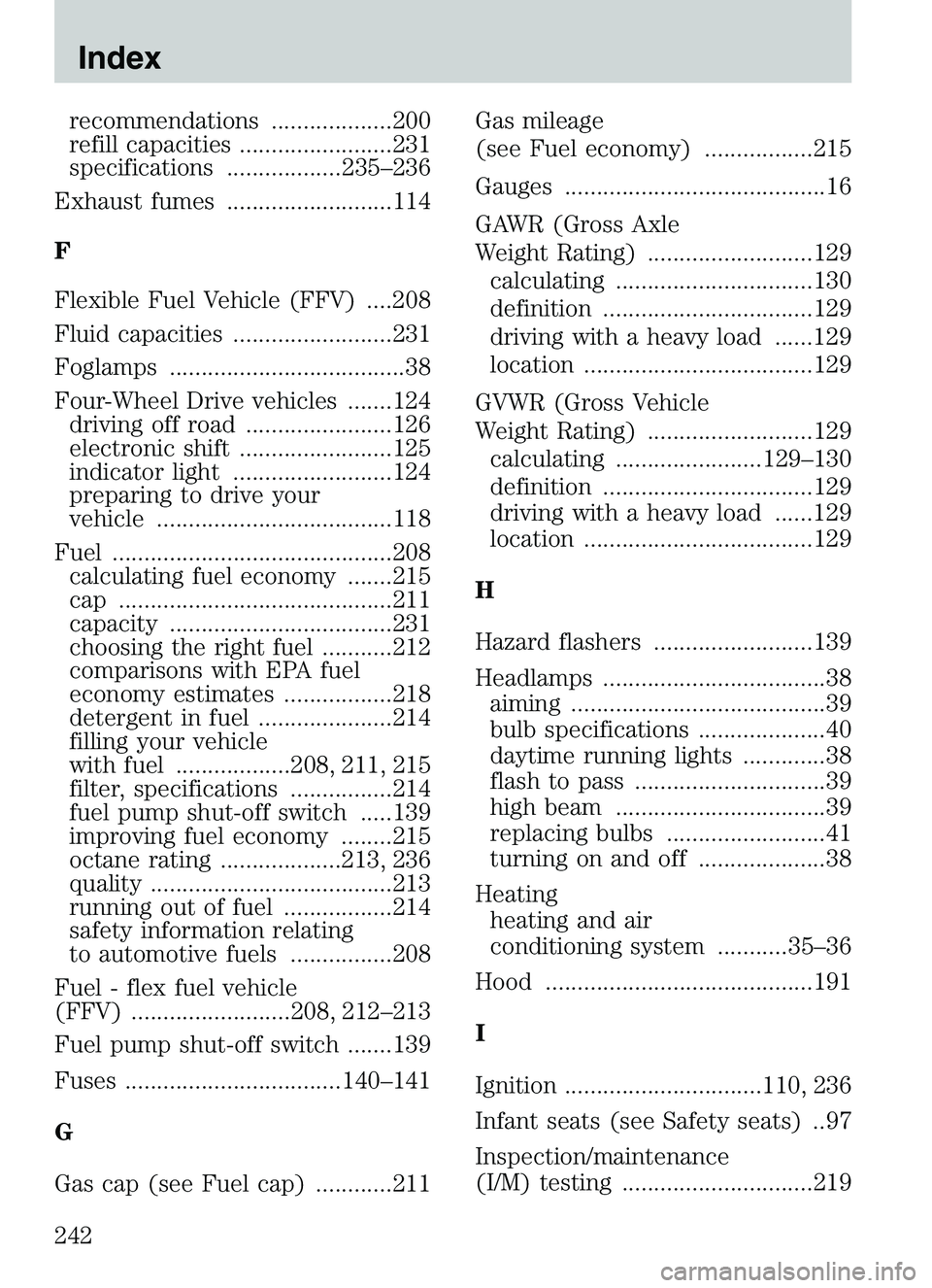
recommendations ...................200
refill capacities ........................231
specifications ..................235–236
Exhaust fumes ..........................114
F
Flexible Fuel Vehicle (FFV) ....208
Fluid capacities .........................231
Foglamps .....................................38
Four-Wheel Drive vehicles .......124 driving off road .......................126
electronic shift ........................125
indicator light .........................124
preparing to drive your
vehicle .....................................118
Fuel ............................................208 calculating fuel economy .......215
cap ...........................................211
capacity ...................................231
choosing the right fuel ...........212
comparisons with EPA fuel
economy estimates .................218
detergent in fuel .....................214
filling your vehicle
with fuel ..................208, 211, 215
filter, specifications ................214
fuel pump shut-off switch .....139
improving fuel economy ........215
octane rating ...................213, 236
quality ......................................213
running out of fuel .................214
safety information relating
to automotive fuels ................208
Fuel - flex fuel vehicle
(FFV) .........................208, 212–213
Fuel pump shut-off switch .......139
Fuses ..................................140–141
G
Gas cap (see Fuel cap) ............211 Gas mileage
(see Fuel economy) .................215
Gauges .........................................16
GAWR (Gross Axle
Weight Rating) ..........................129
calculating ...............................130
definition .................................129
driving with a heavy load ......129
location ....................................129
GVWR (Gross Vehicle
Weight Rating) ..........................129 calculating .......................129–130
definition .................................129
driving with a heavy load ......129
location ....................................129
H
Hazard flashers .........................139
Headlamps ...................................38 aiming ........................................39
bulb specifications ....................40
daytime running lights .............38
flash to pass ..............................39
high beam .................................39
replacing bulbs .........................41
turning on and off ....................38
Heating heating and air
conditioning system ...........35–36
Hood ..........................................191
I
Ignition ...............................110, 236
Infant seats (see Safety seats) ..97
Inspection/maintenance
(I/M) testing ..............................219
2003 Mazda B Series (mbs)
New Owners Guide own2002 (own2002)
USA English (fus)
Index
242